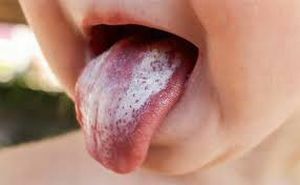 Most often, candidiasis or thrush infects newborn babies during labor, swallowing liquid with bacteria. Also, a mother can infect a baby with an infection while breastfeeding, especially if the nipples have cracks.
Most often, candidiasis or thrush infects newborn babies during labor, swallowing liquid with bacteria. Also, a mother can infect a baby with an infection while breastfeeding, especially if the nipples have cracks.
In addition to newborns and infants, pre-school children suffer from this problem in the absence of proper hygiene and hygiene, especially for girls.
Contents
- Features of baby thrush
- Causes and pathogenesis of
- Where can a fungus "settle"?
- Mucosal infection
- Skin incision
- Visceral or systemic
- Allergenic reactions
- Characteristic clinic
- What you need to know about the fungus that has settled in the mouth
- Causes and symptoms
- Diagnosis
- Comprehensive treatment approach
- Preventive measures
- Dangerous fungus
Characteristics of infant thrush
This is a type of fungal infection caused by yeast-like fungus of the Candida genus of the opportunistic microorganism groups.
This unicellular microorganism is found in most healthy people on the surface of the mucous membranes of the intestine, mouth, tonsils, pharynx, genitalia and is an integral part of a healthy microflora.
Modern studies have established about 150 species of microorganism, 20 of which are capable of causing disease in a healthy person by destroying the mucosa membrane by releasing a huge number of enzymes that break down proteins and fats.
In the mouth of a child, the fungus settles mainly in infancy, since the immature baby body does not yet have the appropriate antibodies to fight the pathogen. Also, various 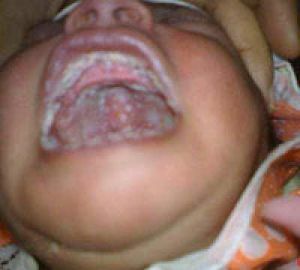 associated health problems may contribute to the onset of the disease in infants:
associated health problems may contribute to the onset of the disease in infants:
- diabetes mellitus;
- diseases of the gastrointestinal tract, decreased acidity of gastric juice, achilles;
- acute chronic infections;
- obesity;
- Other medical conditions.
All these deviations lead to a violation of the assimilation of vitamins. Most often, the disease manifests itself in the hot season and with a large consumption of sweet and flour foods.
Causes and pathogenesis of
Thrush can develop in a baby not only with weakened immunity or during passage through infected generic pathways, but also:
- with poor oral hygiene;
- during the intake of antibiotics, hormones, immunosuppressors;
- with insufficient or unbalanced diet;
- thrush fungus actively multiplies in the air, while it easily survives freezing and drying.
You can get infected:
- by airborne droplets;
- contact-household;
- in utero.
Infection occurs at a rapid pace, affecting new areas of the skin and mucosa and leading to the generalization of the disease.
Particularly difficult is the disease in infants on artificial feeding.
In preschool and primary school children, the problem appears rarely, but they can be a bearer of a dispute.
The sensitizing ability of the fungus plays a major role in the pathogenesis of the disease, which affects to a varying degree the reactivity of the organism and leads to allergic reactions aggravating the situation and determining the course of the disease.
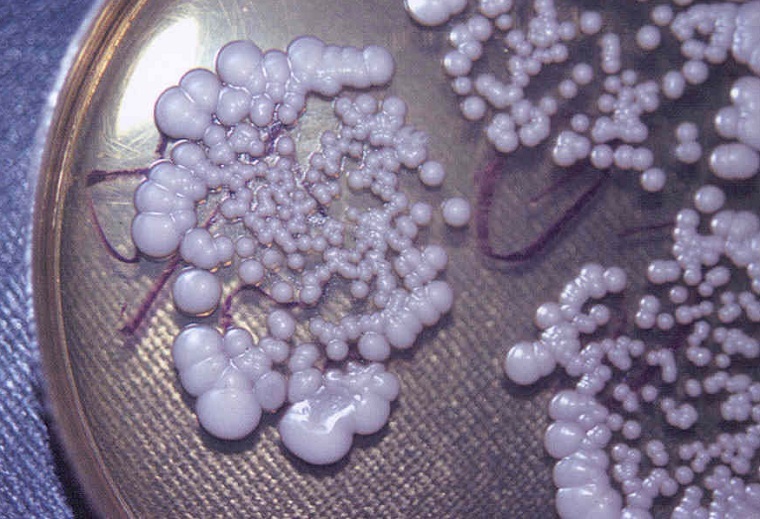
On the photo a scraping, on which Candida fungus under the microscope
Where can the "settling" fungus?
Candidiasis can manifest in a child on almost any part of the body.
Infection of mucous membranes
Fungus can appear in the mouth or on the genitals:
- Lesion of mucous tongue, cheeks, lips, gums, palate .White patches appear as islets, and then merge, with prolonged absence of treatment become dense and grayish, it is almost impossible to remove them.
- Candidial angina is a consequence of problems in the mouth, spores of the fungus spread to the tonsils and throat. If
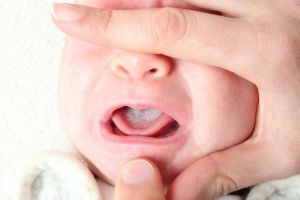 does not use aerosols, then Candida applies to the trachea and bronchi, changing the timbre of the voice. The main difference from other types of infection is the absence of temperature.
does not use aerosols, then Candida applies to the trachea and bronchi, changing the timbre of the voice. The main difference from other types of infection is the absence of temperature. - The lesion of the corners of the lips appears in both corners with a mild aura of inflammation unlike streptococcal infection.
- The defeat of the red border of the lips appears in combination with infection of the mucosa, manifested in swelling and swelling of the lip contour.
- Vulvovaginitis is accompanied by white discharge from the genital organs, when examined by a gynecologist, white layers are found on the cervix, in the vagina, on the mucous membrane of the genital organs.
Throat skin asion
There are two types:
- intertriginous type appears in infants in large folds of the skin, which is hyperimposed, the process is accompanied by erosion;
- candidiasis of smooth skin is also a problem of babies due to the development of thrush in the folds, rarely the children are affected by the scalp.
Visceral or systemic
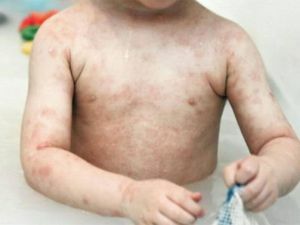
On photo chronic generalized candidiasis
Chronic generalized granulomatous candidiasis occurs in children with gastrointestinal tract and bronchus or with poor nutrition. It begins with the oral cavity and affects almost all areas of the skin with hyperemic spots of cyanotic color with peeling and infiltration.
The visceral type affects the lungs and does not differ from tuberculosis in X-ray examination.
When systemic infection with Candida fungus is possible:
- Intestinal infection - the esophagus is strongly destructive in this case, fungal overlap is so dense that the newborn refuses and tears. Candidiasis of the intestine is accompanied by colitis, watery bloody stool, bloating in the baby.
- The stomach disease is determined only by histological examination, it rarely develops in children, there is no plaque, ulcers of the hyperemia of the stomach are observed.
- Urinary tract damage is expressed in the occurrence of urethritis, cystitis, pyelitis, nephritis. This species can affect the valves of the heart, cause meningitis and meningoencephalitis, the disease proceeds sluggishly with a slight increase in temperature. Such complications are typical for infants and young children.
- Candida sepsis is the most terrible form of the fungus, it usually begins through the mouth, and then through the blood spreads to all organs.
Allergenic reactions
Appear as a result of the fungus in the form of urticaria, bronchial asthma and other problems.
Typical clinic
Allergenic form of thrush causes discomfort - the rash irritates skin areas, the whole process is accompanied by itching and flaking, with asthma attacks the baby does not have enough air, which is caused by bronchial spasms.
The visceral variant leads to the development of microorganisms on vital organs, erosion is bleeding, and serological reactions are positive, the disease can occur, both in a chronic sluggish form and acute.
During the defeat of the skin there is peeling, itching, deposition in the folds of keratinized pieces of epithelium.
With the development of candida on the mucosa appears plaque, damaged organs become inflamed, blush, itch, there are discharges with vulvovaginitis, dryness and bloody wounds. If the intestine is damaged, there is a violation of the stool consistency.
Candidiasis of the oral cavity, as the most common type of infection of the Candida fungus among children, will be considered in more detail.
What you need to know about the fungus that settled in the mouth
The most common thrush in children settles on the mucous membranes of the mouth. The reason for this is not only the mother, as the carrier of the fungus, but also the medical personnel in the maternity homes, poor quality care in the hospital.
Causes and symptoms of
Among other provoking factors are the following: 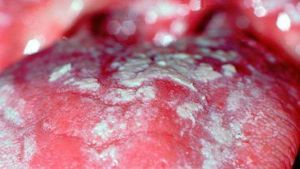
- the presence of congenital somatic diseases;
- abuse of medicines, such as antibiotics;
- poor hygiene of the nursing mother - poor quality nipple treatment and the presence of cracks in them;
- unbalanced food of children after a year - a large amount of flour, sweet and food containing carbohydrates;
- poor handling of children's toys, since kids under 3 years old are all trying on the tooth.
When the thrush is just beginning, the baby has small patches on the mucosa, but over time, the child has other symptoms characteristic of candidiasis:
- he is irritated with warm or spicy foods;
- refuses to eat or breast at all because of discomfort when swallowing;
- complains of dryness and burning;
- tongue, the sky and lips acquire an inflamed appearance, a white coating appears on the mucous membranes.
Diagnosis of
Diagnosis of thrush is carried out by means of:
- visual examination - the curdled plaque is being investigated;
- seen enlarged inflamed parts of the body;
- studies erosive formations.
Also during the detection of fungal formations, laboratory tests and PCR are used. Use cultural studies, using a microscope.
During the determination of candidiasis pneumonia, laboratory tests are performed and the general condition of the patient is taken into account.
A comprehensive approach to the treatment of
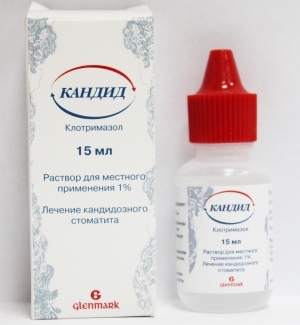 If you start treatment of candidiasis in children in the early stages, this will provide a quick solution to the problem. For first aid, you must use a solution of drinking soda in the amount of a teaspoon per glass of warm water. Wipe the mouth with a solution every 2 to 3 hours.
If you start treatment of candidiasis in children in the early stages, this will provide a quick solution to the problem. For first aid, you must use a solution of drinking soda in the amount of a teaspoon per glass of warm water. Wipe the mouth with a solution every 2 to 3 hours.
It is also not superfluous to provide baby with vitamin B and rational nutrition, the main place in which allocated protein food.
If the damage to the oral mucosa is very strong, then a cream or solution containing clotrimazole, which is prescribed for the treatment of infants, should be used.
To remove the plaque from the oral cavity of the baby, you must use special tissues or fingertips made of hypoallergenic tissue.
Children in a more mature age are treated with borax in glycerin, Jodolipt.
If the disease is protracted and / or complicated, apply:
- antifungal tablets;
- intramuscular injections of B vitamins;
- intravenous saturation with amphotericin;
- immunomodulators.
Having started timely quality treatment, the body quickly copes with the development of the disease once and for all.
Preventive measures of
To avoid the development of candidiasis in children, it is necessary: 
- to rationally use medicines, especially antibiotics, only on doctor's prescription;
- if antibiotics can not be avoided, then it is necessary to apply them simultaneously with antifungal drugs;
- restrict the communication of newborns with people with obvious signs of candidal skin and mucous membrane damage;
- to form for the kid the rational balanced menu;
- daily perform hygienic procedures for the skin and oral cavity of the baby;
- engaged in quenching children.
For teens it is important:
- to avoid unprotected and accidental sexual contacts;
- wear cotton underwear.
Dangerous "fungus"
In the absence of treatment or with improper self-medication, Candida can become resistant to antifungal medicines and then treatment becomes more difficult.
The most dangerous thing in this case is the appearance of a chronic form or sepsis, which can lead to death.
The presence of fungus in large quantities in the intestine leads to perforation of the walls, bleeding and ulceration.
